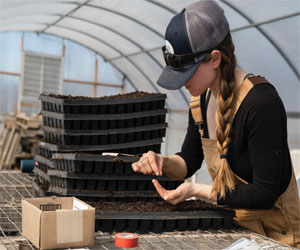


Cultivating A Passion For Gardening

Green thumbs, often described as individuals with an innate talent for gardening, seem to have an almost magical ability to coax lush, vibrant life from the earth. But is having a green thumb truly a gift bestowed upon a select few, or can it be cultivated and nurtured by anyone? In this article, we'll explore the concept of green thumbs, unravel the mysteries behind them, and offer insights into how you can develop your own green thumb.
Defining The Green Thumb
A "green thumb" is a colloquial term that signifies a person's natural aptitude and success in gardening. Those with green thumbs seem to effortlessly grow thriving plants, lush gardens, and abundant crops. They have a knack for understanding the needs of plants, diagnosing issues, and nurturing them to flourish. Many people believe that this ability is an inborn talent, but the reality is more nuanced.
The Science Of Green Thumbs
While some individuals may have a more intuitive understanding of plants due to their upbringing or exposure to gardening from a young age, the concept of the green thumb is not solely based on genetics. Instead, it is rooted in knowledge, experience, and a deep appreciation for the natural world.
Education: Green thumbs often have a solid understanding of horticulture, botany, and gardening techniques. This knowledge allows them to make informed decisions about planting, soil preparation, and care.
Observation: Successful gardeners pay close attention to their plants. They observe growth patterns, spot issues early, and take corrective action, ensuring that plants receive the right care.
Experimentation: Green thumbs aren't afraid to try new things. They experiment with different plants, techniques, and approaches to discover what works best in their specific environment.
Patience: Gardening requires patience and dedication. Green thumbs are willing to invest time and effort in their gardens, understanding that success often comes with experience.
Cultivating Your Own Green Thumb
While not everyone is born with a green thumb, anyone can develop their gardening skills and passion for plants. Here are some tips to help you nurture your own green thumb:
Start Small: Begin with a few easy-to-grow plants or a small garden bed. This allows you to gain experience without feeling overwhelmed.
Learn Continuously: Read books, take online courses, and seek advice from experienced gardeners. The more you know, the more confident and skilled you'll become.
Practice Patience: Understand that gardening is a process, and not everything will go perfectly. Mistakes are part of the learning journey.
Observe Your Garden: Spend time in your garden regularly. Watch how your plants respond to different conditions, and adjust your care accordingly.
Experiment And Adapt: Don't be afraid to try new plant varieties or gardening methods. Adapt your approach based on what works best for your specific environment.
Green thumbs are not solely the result of innate talent; they are cultivated through a combination of knowledge, experience, and a passion for plants. Gardening is a skill that can be honed and refined over time, and the joys of watching your garden thrive are accessible to all who are willing to embrace the journey. So, roll up your sleeves, get your hands dirty, and embark on the adventure of nurturing your very own green thumb.
Maximizing Space And Minimizing Clutter
 3. Under-Bed Storage
3. Under-Bed Storage
Utilize the space beneath your bed for storage. Under-bed drawers or storage containers are an excellent way to store items like shoes, clothing, or seasonal bedding. This not only frees up closet space but also keeps your belongings easily accessible.
4. Kitchen Cabinet Organizers
Maximize kitchen storage with cabinet organizers. Pull-out shelves, drawer dividers, and pull-down racks can help you make the most of your kitchen cabinets, keeping your cookware, utensils, and pantry items neatly organized and accessible.
5. Wall-Mounted Shelves
Wall-mounted shelves are a versatile and stylish solution for adding storage space to your home. They can be used in various rooms to display decor, hold books, or store everyday items. By taking advantage of vertical space, you can free up floor space and reduce clutter.
6. Over-Door Storage
Over-door storage solutions are perfect for optimizing small spaces. Hanging racks, hooks, and pockets can be attached to doors to store shoes, accessories, cleaning supplies, or pantry items. These solutions maximize space while keeping items within easy reach.
7. Floating Furniture
Floating furniture, like wall-mounted vanities, desks, and entertainment centers, can make a room feel more spacious by creating the illusion of more floor space. These pieces not only look sleek but also offer storage underneath.
8. Clear Containers And Labels
Clear storage containers are essential for efficient organization. They allow you to see the contents without having to open each container. Use labels to further categorize and identify your belongings, making it easy to find what you need.
 The Rise Of Greenhouse Farming
The Rise Of Greenhouse Farming
Greenhouse farming, also known as protected cultivation, has witnessed a significant surge in popularity over recent decades. This surge can be attributed to several factors, including the increasing demands for year-round crop production, the need for protection against adverse weather conditions, and the conservation of resources in a sustainable manner.
Year-Round Crop Production
One of the most notable advantages of greenhouse farming is the ability to grow crops throughout the year, regardless of the external climate. Greenhouses provide a stable and controlled environment where temperature, humidity, and light levels can be regulated to meet the specific needs of different crops. This means that farmers are not restricted to the traditional growing seasons, leading to increased crop diversity and a more reliable food supply.
Optimal Environmental Control
Greenhouses offer precise control over environmental factors. With advanced climate control systems, farmers can adjust temperature, humidity, and CO2 levels to create ideal conditions for plant growth.
Ensuring Safe And Sustainable Water Supply
 Rainwater is naturally soft and low in mineral content, making it an appealing alternative water source. In areas where access to clean, safe drinking water is limited, treating rainwater can provide a reliable supply. Additionally, rainwater treatment supports sustainable water management practices by reducing the burden on traditional water sources.
Rainwater is naturally soft and low in mineral content, making it an appealing alternative water source. In areas where access to clean, safe drinking water is limited, treating rainwater can provide a reliable supply. Additionally, rainwater treatment supports sustainable water management practices by reducing the burden on traditional water sources.
The Rainwater Treatment Process
Filtration: The first step in rainwater treatment is filtration. This process involves the removal of physical impurities such as leaves, twigs, and debris. Mesh screens and sediment filters are commonly used for this purpose.
Storage: Rainwater is often collected in storage tanks or cisterns. Proper storage is essential to prevent the growth of algae and the contamination of the water by external factors.
Settling: Allowing the collected rainwater to settle can help separate fine particles and sediments that may have passed through the filtration process. This is especially important for improving water quality.
Chemical Treatment: To disinfect rainwater and eliminate pathogens, chemical treatments are employed. Chlorine or ultraviolet (UV) light can effectively kill bacteria and viruses, ensuring safe water for drinking and household use.
Carbon Filtration: Activated carbon filters can be used to remove organic compounds, odors, and residual chemicals from rainwater, enhancing its taste and quality.
Reverse Osmosis: For potable water, reverse osmosis systems can be used to further purify rainwater by removing dissolved minerals, heavy metals, and other contaminants.
Applications Of Treated Rainwater
Drinking Water: When appropriately treated, rainwater can be a safe and reliable source of drinking water in areas with limited access to clean water.






The Future Of Modern Living
 What Are Smart Appliances?
What Are Smart Appliances?
Smart appliances are traditional household devices, such as refrigerators, ovens, washing machines, and even coffee makers, that are equipped with advanced technology and connectivity features. These features allow them to be remotely controlled and monitored through a smartphone app or voice-activated virtual assistants. Smart appliances can perform a wide range of functions, from adjusting settings to sending notifications and alerts.
Convenience And Efficiency
One of the most significant advantages of smart appliances is the level of convenience they bring to everyday tasks. Imagine being able to preheat your oven on your way home, so dinner is ready as soon as you arrive. Smart appliances enable you to control and monitor their functions from virtually anywhere, giving you more control over your daily routines.
Energy Efficiency And Cost Savings
Smart appliances are designed to be energy-efficient. They often include features like energy-saving modes, remote scheduling, and real-time consumption tracking. For instance, smart thermostats can learn your heating and cooling preferences and create optimized schedules, which not only improve comfort but also save on energy costs. Smart appliances not only benefit your wallet but also contribute to environmental sustainability.
Integration With Smart Homes
Smart appliances are designed to be compatible with other smart home devices and systems. They can seamlessly integrate with centralized home automation hubs, allowing you to control multiple devices from a single app or voice-activated virtual assistant. This interconnected ecosystem enhances the overall smart home experience.
Understanding And Mitigating Our Footprint
 2. Habitat Destruction: Human activities, including urbanization, agriculture, and industrial development, have led to the destruction of natural habitats. This results in the loss of biodiversity, as many plant and animal species face extinction due to habitat loss and fragmentation. Preserving natural habitats is essential to maintaining the Earth's rich biodiversity.
2. Habitat Destruction: Human activities, including urbanization, agriculture, and industrial development, have led to the destruction of natural habitats. This results in the loss of biodiversity, as many plant and animal species face extinction due to habitat loss and fragmentation. Preserving natural habitats is essential to maintaining the Earth's rich biodiversity.
3. Pollution: Pollution takes various forms, including air pollution, water pollution, and soil contamination. Pollutants emitted from industrial, agricultural, and residential sources can harm both the environment and human health. Air pollution leads to respiratory problems, while water pollution impacts aquatic ecosystems and can contaminate drinking water sources.
4. Resource Depletion: The overexploitation of natural resources, such as freshwater, minerals, and forests, depletes these finite resources at an unsustainable rate. This not only threatens the availability of essential resources but also contributes to habitat destruction and environmental degradation.
5. Plastic Pollution: The excessive use and improper disposal of plastic products have resulted in a global crisis of plastic pollution. Plastics take hundreds of years to decompose, and their accumulation in oceans, waterways, and ecosystems poses significant risks to wildlife and ecosystems.
6. Deforestation: Deforestation, primarily driven by agriculture and logging, has far-reaching consequences. It contributes to habitat loss, reduces carbon sequestration, and disrupts global climate patterns. It also affects indigenous communities that rely on forests for their livelihoods.
7. Overfishing: Overfishing and unsustainable fishing practices threaten marine ecosystems and the livelihoods of communities that depend on fisheries. It depletes fish populations and disrupts the balance of marine ecosystems.